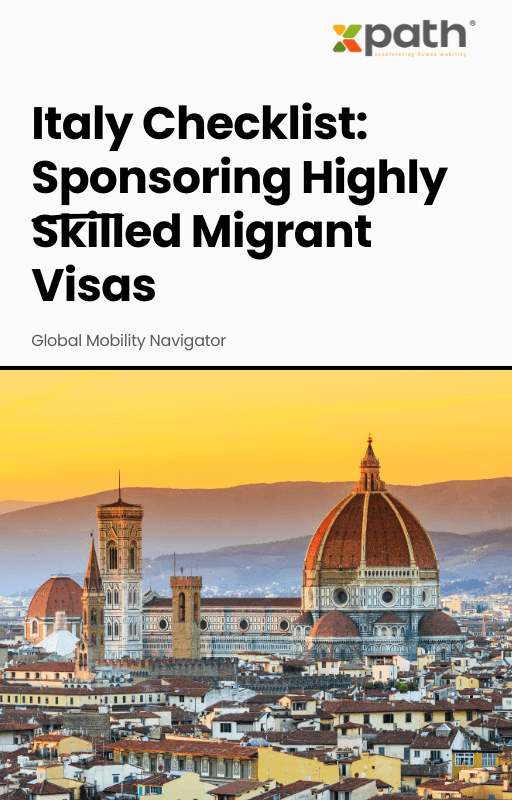Italy Checklist: Sponsoring Highly Skilled Migrant Visas
Grab a copy of a guide to international employee relocation
View E-bookAs we step into the year 2024, the landscape of global mobility is continually evolving, presenting both challenges and opportunities for organizations. To navigate this ever-changing terrain successfully, it is crucial to master the fundamentals of global mobility policies. In this comprehensive guide, we will explore key trends and strategies for global mobility in 2024 and beyond. By understanding the importance of operational excellence, employee experience, strategic alignment, assignment success, and the positive feedback loop, organizations can build a resilient and highly valued global mobility function.
In 2024, operational excellence is no longer just a goal but a necessity for successful global mobility programs. With the increasing use of technology solutions and the decreasing cost and implementation barriers, organizations have the opportunity to achieve new heights of operational efficiency. Embracing the power of artificial intelligence (AI) can redefine the way global mobility is managed, ensuring compliance and efficiency in an ever-complex world. By leveraging AI technologies, organizations can streamline processes, enhance decision-making, and provide personalized relocation and assignment solutions.
The year 2024 marks a shift towards a highly personalized employee experience in global mobility. Each employee brings unique expectations and needs, which require tailored approaches beyond standard procedures. To boost employee satisfaction and retention, organizations must prioritize the employee experience. This can be achieved by aligning global mobility programs with company-wide initiatives, developing stand-alone approaches, and incorporating flexibility and inclusion. By providing comprehensive support throughout the entire relocation and assignment process, organizations can create a positive and engaging experience for their employees.
In 2024, strategic alignment is essential for global mobility programs to become strategic assets. With the increasing availability of data and analytics, organizations have the opportunity to align mobility strategies with business objectives. Securing stakeholder buy-in is crucial for fostering unified support and direction, ensuring that global mobility strategies are in line with the overarching goals of the organization. By embracing agility and adaptability, organizations can transform their global mobility function into a driver of business outcomes.
Assignment success in 2024 goes beyond logistics and compliance. It encompasses holistic support, including mental health and well-being. Organizations are adopting comprehensive approaches to ensure the overall success of international assignments, focusing on the well-being of employees and their families. Additionally, ESG initiatives in global mobility are gaining importance, integrating eco-friendly relocation solutions, championing diversity and inclusion, and enhancing governance with data-driven transparency. By embedding a well-being agenda and implementing ESG initiatives, organizations can create a supportive and sustainable environment for their global workforce.
Building a positive feedback loop is essential for elevating the role of global mobility within organizations. While collecting feedback from employees is crucial, extending these processes to include open and ongoing communication with internal teams and external vendors can lead to continuous enhancements in global mobility strategies. By encouraging two-way feedback and implementing self-assessment modules, organizations can achieve consistent growth and better adaptability. Cultivating a culture of continuous improvement and collaboration can contribute to the success of global mobility programs.
Artificial intelligence (AI) is revolutionizing the global mobility landscape. HR departments are increasingly leveraging AI for resume screening, candidate assessment, and even chatbot interactions. As we move into 2024, AI’s role in global mobility policies is expected to expand further and generative AI will radically change the HR tech landscape. By harnessing the power of AI, organizations can generate customized policies efficiently and cost-effectively. AI can also analyze immigration, legal, tax, and compliance considerations, ensuring a seamless and compliant relocation or assignment process.
Diversity, equity, inclusion, and belonging (DEI&B) are no longer optional in global mobility policies. In a time where diversity policies face full-out attacks, organizations must exhibit a renewed commitment to DEI&B initiatives. By updating global mobility policies to prioritize diversity and flexibility, organizations can create an environment that supports individual differences and fosters a sense of belonging. Greater flexibility can be achieved by offering a wider range of relocation benefits and support services tailored to the unique needs of each employee.
Environmental sustainability is a pressing global issue, and organizations are increasingly incorporating sustainability initiatives into their global mobility policies. Securing investor funding and enhancing employer branding often hinge on sustainable practices. By integrating eco-friendly relocation solutions, organizations can reduce their carbon footprint and contribute to a greener future. Additionally, sustainability efforts can extend to championing diversity and inclusion in assignments and enhancing governance through data-driven transparency.
Technology plays a crucial role in enhancing employee engagement and support in global mobility programs. Communication tools such as Slack and Teams facilitate seamless collaboration between on-site and remote employees. Feedback platforms like Peakon and SurveyMonkey enable organizations to gather employee input and measure the success of various initiatives. Mental health platforms like Mindsurance connect relocated employees with professionals who can provide support. By leveraging technology, organizations can bridge the gap between employees, enhance communication, and promote employee well-being.
Strategic stakeholder alignment is vital for global mobility program success, requiring alignment with organizational goals to secure buy-in and support. Demonstrating the value and impact of mobility initiatives fosters alignment and integration with overarching business strategies.
In an ever-evolving landscape, building resilience and agility within global mobility functions is crucial. Investing in training and development equips teams with the skills to navigate change effectively. Fostering adaptability ensures long-term success amidst evolving market trends and technologies.
As this guide concludes, organizations must prioritize operational excellence, employee experience, strategic alignment, assignment success, and the positive feedback loop to thrive in the evolving global mobility landscape. By leveraging technology, embracing diversity and sustainability, and fostering stakeholder alignment, organizations build a resilient and adaptive global mobility function, embarking on a journey into the future with confidence.

Italy Checklist: Sponsoring Highly Skilled Migrant Visas
Grab a copy of a guide to international employee relocation
View E-book